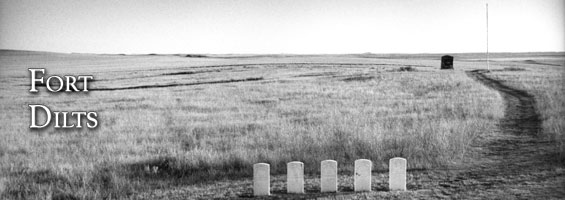Weâre launching a new web portal! Visit findhistory.nd.gov to search our collections.

Fort Dilts State Historic Site marks the site of a dramatic episode in North Dakota history where emigrants in an embattled wagon train circled their wagons and waited for rescue by the cavalry. Fort Dilts appears today much as it did more than one hundred years ago in its pristine setting eight miles northwest of Rhame, Bowman County.
On July 15, 1864, Captain James L. Fisk, U.S. Quartermaster Corps, led ninety-seven wagons out of Fort Ridgely, Minnesota, for the gold fields of western Montana and Idaho. This was a dangerous journey of more than a thousand miles during an era of increased hostilities after the US-Dakota of 1862 (see Sibley and Sully Expeditions of 1863). Fisk proposed to follow a new, shorter route across unmapped territory from Fort Rice, Dakota Territory, west to the Bighorn River, in what is now Montana.
Believing that General Sully and his army preceded them, Fisk left Fort Rice, Dakota Territory, with a small military escort of fifty convalescent soldiers. Eighty miles west of Fort Rice, Fisk discovered that General Sully’s trail veered north, and he realized that the train was now reliant upon their small escort. The wagon train was attacked by Hunkpapa Lakota Indians on September 2, nearly 180 miles from the fort. Sullys attack on the Indian village at Killdeer Mountain had occurred five weeks earlier, and the running battle through the Badlands between Sully and the Lakotas had lasted into early August. The Lakota warriors were in no mood to allow any military-escorted wagon train to pass through their territory. The Lakota attack left nine people from the wagon train dead and three seriously wounded.
During the following two days, the train moved twelve miles while constantly harassed by the Hunkpapa warriors. Maȟtó Watȟápa (John Grass), a Lakota leader was present at the siege.
One member of the wagon train was wounded. Progress was slow, and soldiers had to use a howitzer to clear the way in front of the train. On September 4, the members of the wagon train found a defensive point where they could dig in until reinforcements could arrive from Fort Rice. During the next few days, the men cut sod and stacked it to a height of six and one-half feet in a defensive perimeter 300 feet in diameter. It was christened Fort Dilts by members of the wagon train in honor of Corporal Jefferson Dilts, who died from his wounds and was buried in the entrenchments. Two other soldiers, Marma D. Betts and Thomas C. Williamson, were also buried in the sod wall.
Lieutenant Smith and fifteen comrades rode for help, arriving at Fort Rice four days later. Early on the morning of September 20, the emigrants spotted twenty to thirty horsemen on a ridge north of camp. They were the advance party of Colonel Daniel J. Dill, who was a few miles behind with 400 cavalry soldiers, 400 infantrymen, and a section of artillery from Fort Rice. The Hunkpapa warriors retreated, and the sixteen-day siege came to an end. The frightened gold seekers returned to Fort Rice where the expedition disbanded.
A diary of the battle kept by William L. Larned describes the events and setting in vivid detail, and many of the features are still visible, including the sod wall, wagon ruts, graves, and an uncompleted well. Archaeological excavations confirm the site is essentially undisturbed. The only modern intrusions are a flagpole, a site marker, a registration box, a barbed wire fence, and an interpretive sign north of the fortification remains.
SHSND Address:
612 East Boulevard Ave.
Bismarck, North Dakota 58505
Get Directions
SHSND Hours:
Museum Store: 8am - 5pm M-F; Sat. & Sun. 10am - 5pm.
State Archives: 8am - 4:30pm., M-F, except state holidays, and 2nd Sat. of each month, 10am - 4:30 pm.
State Historical Society offices: 8am - 5pm M-F, except state holidays.
Contact SHSND:
phone: 701.328.2666
email: history@nd.gov